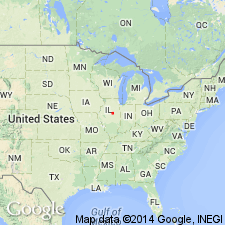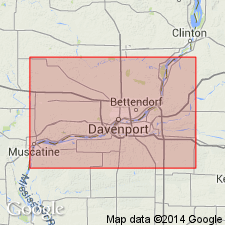
- Usage in publication:
-
- Marcus Formation
- Modifications:
-
- Named
- Dominant lithology:
-
- Dolomite
- AAPG geologic province:
-
- Wisconsin arch
Summary:
Marcus Formation named in northwestern IL for village in Carroll Co. Exposed in quarry in Mississippi Palisades State Park. Consists of buff-brown massive, pure dolomite. Thickness 12.2 m at type section; ranges from 10.7 to 13.7 elsewhere. Overlies Sweeney Formation (new) and underlies Racine Formation (new). Age is Middle Silurian (Niagaran).
Source: GNU records (USGS DDS-6; Reston GNULEX).

- Usage in publication:
-
- Marcus Member
- Modifications:
-
- Revised
- Overview
- AAPG geologic province:
-
- Wisconsin arch
Summary:
According to author, one of his primary aims in this report is to strongly encourage adoption of IA nomenclature in adjacent IL. The only major change is the incorporation of the Sweeney and Marcus as members within the Hopkinton and replacement of the Racine with upper members of the Hopkinton, the Scotch Grove Formation, and the Gower Formation. The Hopkinton in the Quad Cities area of IA and IL is divided into (ascending) Sweeney, Marcus, Farmers Creek, and Picture Rock Members. The Marcus resembles the Sweeney, but it is less cherty and contains beds with abundant pentamerid brachiopods.
Source: GNU records (USGS DDS-6; Reston GNULEX).
For more information, please contact Nancy Stamm, Geologic Names Committee Secretary.
Asterisk (*) indicates published by U.S. Geological Survey authors.
"No current usage" (†) implies that a name has been abandoned or has fallen into disuse. Former usage and, if known, replacement name given in parentheses ( ).
Slash (/) indicates name conflicts with nomenclatural guidelines (CSN, 1933; ACSN, 1961, 1970; NACSN, 1983, 2005, 2021). May be explained within brackets ([ ]).

